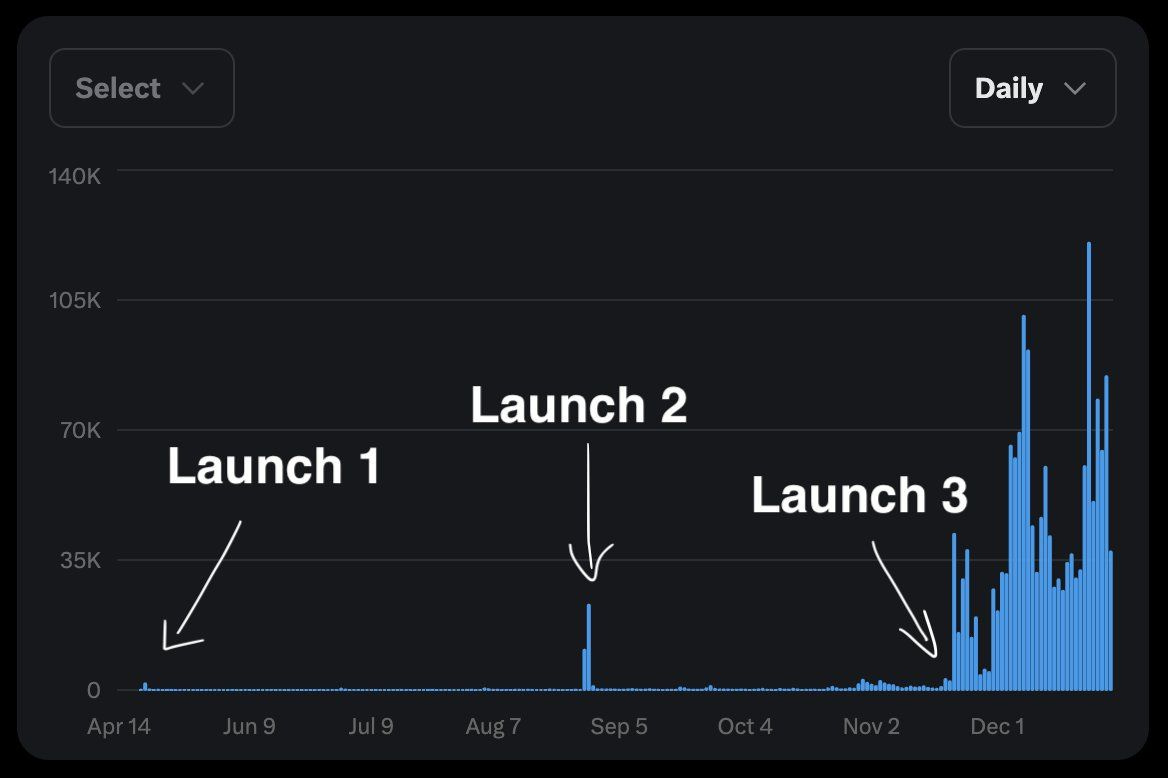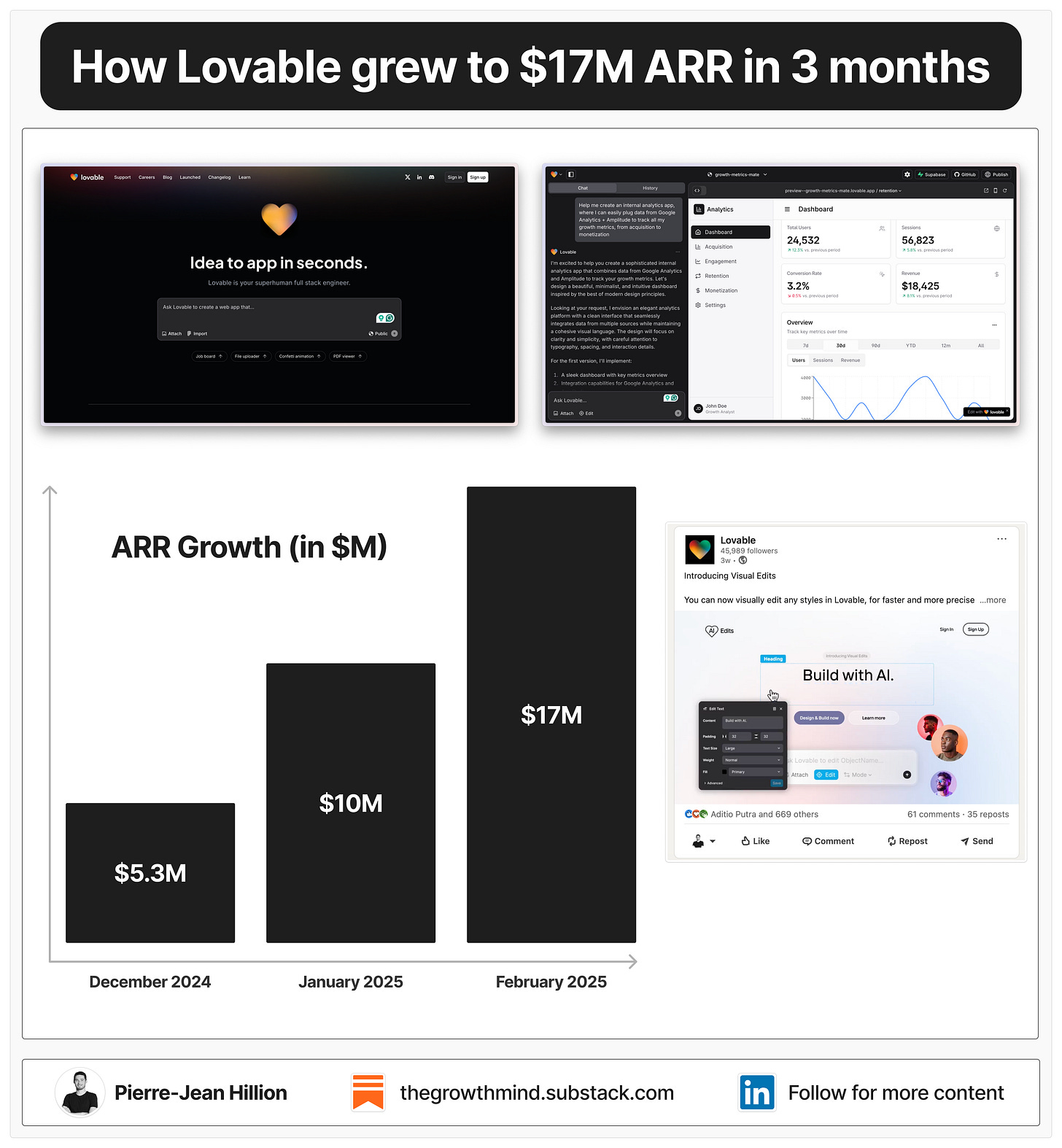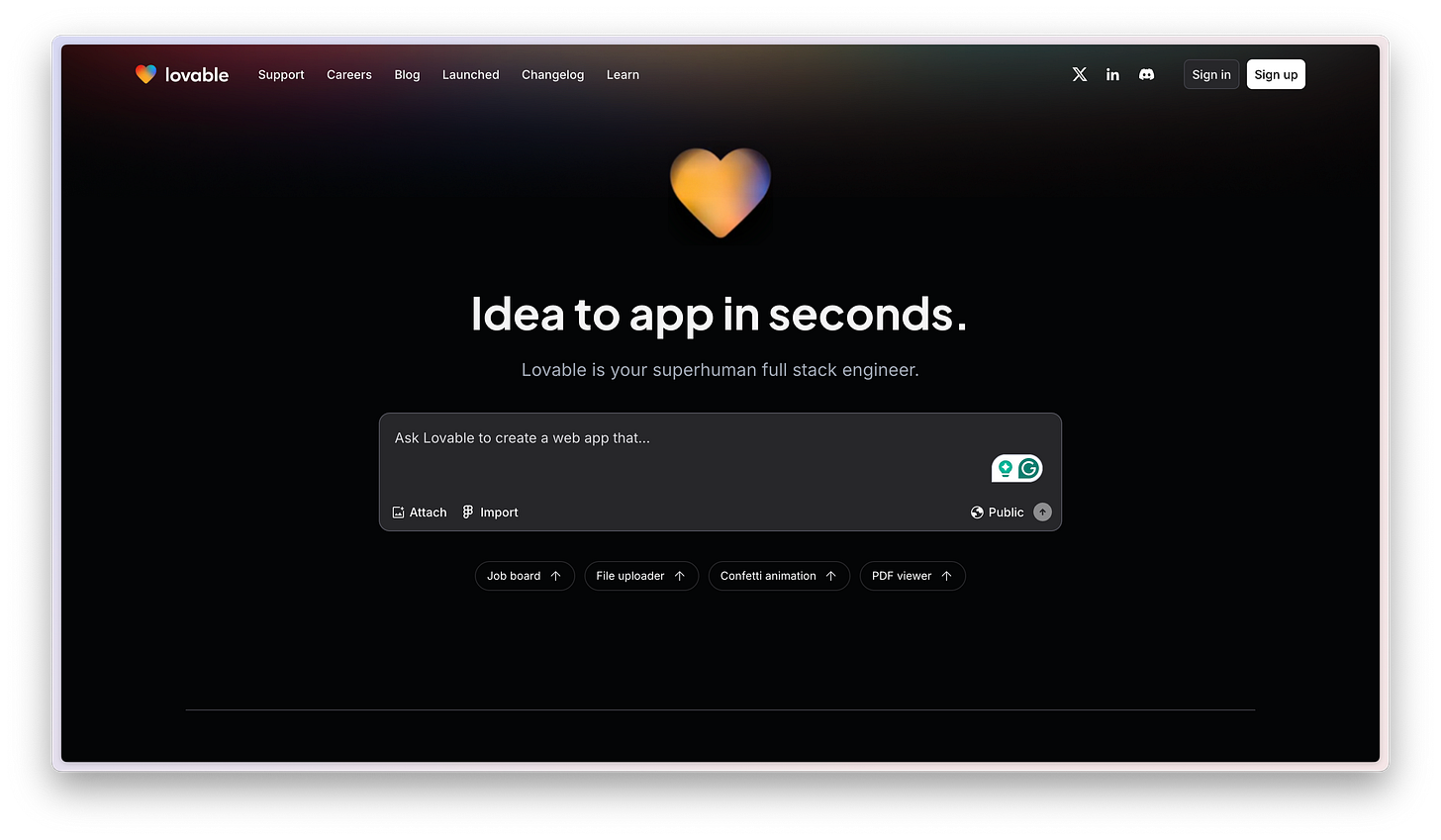How Lovable grew to $17M ARR in 3 months
The story of one of the fastest growing AI startup
Hey, Pierre-Jean here 👋 Welcome to this new edition of The Growth Mind!
In today’s article, we deep dive into the growth story of Lovable, one of (if not the) the fastest AI growing startup.
In 3 months after their launch, Lovable reached:
$17M ARR, adding up to 2M new ARR each week
25,000 new apps created every day
30,000 paying customers
85% one-month retention on paying users (better than ChatGPT)
And they did it with a lean team of 15 people only. Let’s dive into the story behind this massive growth.
⏱️ Reading time → 8 minutes
For more: Best of The Growth Mind | Work with me
Lovable: the European 🇪🇺 AI startup that makes software development accessible to anyone
Lovable is a Swedish startup, founded in 2023 by Anton Osika and Fabian Hedin.
They started Lovable with a clear but highly challenging vision: enable anyone to create web apps with natural language, without the need to code.
Think of Lovable as a full-stack engineer + designer combined into an AI. Your role is to act as a product manager with Lovable, and give it the right specifications to build the product you want.
They operate in what we now call the “Vibe coding” industry → coding by giving instructions in natural language, and let the AI write the code. This concept, popularized by Andrej Karpathy (ex-Tesla, OpenAI), is not only a trend, but it’s becoming a real market with a huge growth potential.
“This is actually the dominant way to code, and if you’re not doing it, you might just be left behind” - Gary Tan, Y Combinator CEO, about Vibe Coding
Lovable is perfectly positioned to be one of the winners of the vibe coding market.
But what does Lovable concretely do?
Lovable provides a GPT-like interface where you can, with natural language prompts, build a web app. You have access to an editor where you can both develop with prompts, but also visualize your app and the code behind it.
Once your app is ready, you can:
Publish it to make it public on the web.
Add a custom domain: by default, your app is hosted on a Lovable sub-domain if you don’t.
Integrate your app with services like GitHub or Supabase, which help, for example, to easily connect a backend, collaborate with developers, and track app version evolution.
→ Those features make Lovable a real game-changer to create an app, from conception to publication.
From 0 to 17M$ ARR in 3 months: the story behind one of the fastest growing AI startups
1/ Mid-2023 → The launch of GPT Engineer
Before becoming Lovable, the story started with the publication of GPT Engineer, in 2023. It was an open source project, published on GitHub.
The project quickly became the fastest growing code repository project on GitHub, reaching more than 50k stars (think of it as a ProductHunt upvote, but on GitHub).
It was the MVP of Lovable. A V1 to test the traction of what Lovable would become a year later. With such an early traction on developers, the Lovable team quickly understood they had a very, very strong Product/market fit.
2/ April to October 2024 → 2 failed launches before the breakout
Before Lovable became a viral success, the team actually failed twice.
They launched gptengineer.app for the first time in April 2024. Instead of becoming a GitHub repository only, they became a real app.
But things were not working as expected:
The product was good, but not great. The AI code builder was still unreliable for complex apps.
They slowly onboarded users from a waitlist, but traction was limited.
Six months later, they tried again with a second launch.
They saw even more potential, but the AI still got stuck too often.
The core issue was reliability. Users needed an AI that could build real, scalable apps, not just toys.
After months of iteration, they:
Found a system that allowed Lovable to handle large codebases → making it the first AI-powered full-stack engineer.
Built the Supabase integration → allowing users to manage backends easily.
Yet, almost no one knew how good the product had become.
👉 That’s when they decided to pivot to Lovable and did a brand new launch. This time, it worked.

3/ November 2024 → The pivot to Lovable
With the early traction of GPT Engineer, the team realized that they had a much bigger opportunity ahead.
While GPT Engineer was powerful, it still required developers to understand and use it. The audience was still limited. For example, as a limited technical person, I would probably not have been able to really use GPT engineer at that time.
But what if anyone, even non-technical people, could build an app?
This is when Lovable was born.
The team launched a graphical interface, making it accessible to non-developers.
Users could now build and visualize their apps instead of just generating raw code.
The shift dramatically expanded the target audience, from developers to founders, product designers, and marketers.
Lovable was no longer just an AI-powered coding tool. It became a full-stack AI software builder that anyone can use.
4/ January 2025 → A massive early adoption and $7.5M seed round
The pivot worked instantly. Within weeks, thousands of users started testing the new version of Lovable.
From open-source traction to SaaS hypergrowth: GPT Engineer’s community became Lovable’s early adopters.
New user profiles emerged: founders, marketers, and designers who had never coded before.
Viral effect: Lovable became one of the most discussed AI startups on Twitter.
This momentum led to a $7.5M pre-seed round, backed by Hummingbird VC and byFounders. With money in the bank and a skyrocketing user base, Lovable went all-in on product development.
5/ February 2025 → A record-breaking $15M Series A & $17M ARR in 3 months
2 weeks ago, Lovable published an announcement on their blog: they are raising again, but this time $15M.
And it shocked the startup world.
Lovable reached $17M ARR in just 3 months.
30,000 paying customers adopted the platform.
25,000 new apps are created every single day.
Lovable’s growth was so intense that it nearly crashed GitHub.
Investors, who are deeply looking for the next winning AI startups, saw what was happening and rushed in.
They closed a $15M round, led by Creandum, with participation from top tech angels like:
Charlie Songhurst (Meta board)
Thomas Wolf (Hugging Face)
Adam D’Angelo (Quora CEO)
This round solidified Lovable as one of the fastest-growing AI startups in Europe.
Looking back at their journey, it was not an easy thing to reach the success they have today (even if it’s still early compared to its full potential). Nothing happened magically; it was hard work behind the scenes.
The Growth levers that made Lovable skyrocket
Lovable growth is a combination of:
A world-class product execution
A perfect time to enter the market
They executed a near-perfect playbook at the right moment. Let’s break down the key growth levers behind their explosive success.
Build a product people love
The first thing to say about Lovable is that the product is amazing and solving a strong problem: enable non-technical people and empower developers to code faster than ever. They have a strong product/market fit, and evolve in a market that is growing fast.
Being perfectly positioned on the vibe coding market
The Vibe Coding market is rising, especially among non-developers, who now have more power than ever to build. Lovable positioned itself at the perfect intersection:
AI-generated code (for devs)
No-code interface (for non-devs)
This unlocked a much larger market than GPT Engineer:
Solopreneurs launching SaaS MVPs.
Designers skipping Figma and going straight to prototypes.
Sales teams building live interactive demos.
While it’s difficult to find projections on this specific market, as the “Vibe coding” term is very new, we can bet that it will drastically grow over the last couple of years. Being a pioneer like Lovable is a strong advantage.
Community-Led Growth: launching GPT engineer as a Trojan horse
Lovable didn’t start from scratch. They built a community first, monetized later.
GPT Engineer was an open-source hit → 50,000 GitHub stars = instant credibility.
Developers became the first evangelists → Early adopters who spread the word.
Twitter & Dev forums fueled word-of-mouth → No paid ads, just organic virality.
Building in public and turning users into ambassadors
Lovable is constantly publishing updates about the software and their growth, and resharing their users’ achievements, contributing to the hype. Their storytelling is very good.
They share traction numbers in real-time → ARR, number of users, etc.
They engage with the AI & dev community → Tech influencers amplified them.
They turned users into ambassadors → people proudly post their Lovable-made apps. Lovable reshare them practically every day on X.
This creates a FOMO loop: the more they and their users share about Lovable and their explosive growth (as I’m exactly doing here 😉), the more people want to try it.
Growing with controlled spend
It’s been pretty common to see startups burn tens of millions before reaching $17M ARR. But Lovable “only” spent $2M. Even if we’ve entered a profitable growth era since 2022, it’s uncommon to reach that level of ARR so quickly without a crazy amount of capital spent.
To control their spending, they:
Kept the team small and ultra-focused → Only 15 people work at Lovable yet.
No paid acquisition, all organic → Community, virality, and inbound demand.
Laser-focused product roadmap → Every update made the product easier to use.
They grew like an indie hacker, but scaled like a VC-backed startup.
Build powerful product integrations to become an end-to-end engineering companion
To reduce friction and make sure Lovable is not only an app to generate code, they launched strategic integrations with:
Figma → To import a design and start building an app from it
Supabase & Github → Maintain codebase, create a backend, manage versions
Those integrations make it easy to integrate Lovable into your entire app journey, from design to maintenance.
Lovable has all the ingredients to be the European (world?) leader of Vibe Coding in the coming years
I heard about GPT engineer about a year ago, and I remember I was skeptical about it yet. Talking with some developers, it looked like it was not fully ready to build great apps that scale. But the pivot to Lovable has definitely changed it. And I think we can all be impressed by what their team achieved: they executed relentlessly, learned fast, and built something people truly wanted. They failed twice before finding the right formula. They grew without throwing millions in ads. Their storytelling is also a large part of their success.
Anton, Lovable’s CEO, has been clear about their ambition: become a category leader and empower 1M people to build live apps with Lovable.
And honestly, as a French guy, I’m proud that Lovable is an European startup! 🇪🇺
Want to work together? Here are 2 ways I can help you:
Fractional growth lead: I act as your part-time growth lead to design and execute scalable full-funnel strategies. Perfect for startups needing senior-level expertise without committing to a full-time hire.
Growth strategy audit: An audit of your current growth strategy and a co-creation of your growth roadmap, within a few days. You end up with a clear list of priorities and experiments to execute.
→ Available in French 🇫🇷 and English 🇬🇧










Great one, Pierre-Jean!
Lovable and the IDEs are democratising app development and entrepreneurship. I have tried the product itself and its aesthetics are by far the closet to production stage. Thanks for the sharing!